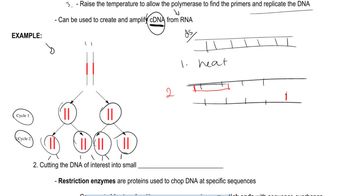Table of contents
- 1. Introduction to Genetics51m
- 2. Mendel's Laws of Inheritance3h 37m
- 3. Extensions to Mendelian Inheritance2h 41m
- 4. Genetic Mapping and Linkage2h 28m
- 5. Genetics of Bacteria and Viruses1h 21m
- 6. Chromosomal Variation1h 48m
- 7. DNA and Chromosome Structure56m
- 8. DNA Replication1h 10m
- 9. Mitosis and Meiosis1h 34m
- 10. Transcription1h 0m
- 11. Translation58m
- 12. Gene Regulation in Prokaryotes1h 19m
- 13. Gene Regulation in Eukaryotes44m
- 14. Genetic Control of Development44m
- 15. Genomes and Genomics1h 50m
- 16. Transposable Elements47m
- 17. Mutation, Repair, and Recombination1h 6m
- 18. Molecular Genetic Tools19m
- 19. Cancer Genetics29m
- 20. Quantitative Genetics1h 26m
- 21. Population Genetics50m
- 22. Evolutionary Genetics29m
18. Molecular Genetic Tools
Genetic Cloning
Problem 2a
Textbook Question
The human genome is 3×10⁹ bp in length. How many fragments would be predicted to result from the complete digestion of the human genome with the following enzymes: Sau3A (˘GATC), BamHI (G˘GATCC), EcoRI (G˘AATTC), and NotI (GC˘GGCCGC)?
 Verified step by step guidance
Verified step by step guidance1
<Step 1: Understand the problem. We need to determine how many fragments result from cutting the human genome with specific restriction enzymes. Each enzyme recognizes a specific DNA sequence and cuts at a specific site.>
<Step 2: Calculate the probability of each recognition site occurring in the genome. For a sequence of length n, the probability is (1/4)^n, assuming equal probability for each base (A, T, C, G).>
<Step 3: Determine the expected number of cuts for each enzyme by multiplying the probability of the recognition site by the total number of base pairs in the genome (3×10⁹ bp).>
<Step 4: Calculate the expected number of fragments for each enzyme. The number of fragments is equal to the number of cuts plus one.>
<Step 5: Summarize the results for each enzyme: Sau3A, BamHI, EcoRI, and NotI, based on their recognition sequences and the calculations from the previous steps.>
Recommended similar problem, with video answer:
 Verified Solution
Verified SolutionThis video solution was recommended by our tutors as helpful for the problem above
Video duration:
9mPlay a video:
Was this helpful?
Key Concepts
Here are the essential concepts you must grasp in order to answer the question correctly.
Restriction Enzymes
Restriction enzymes are proteins that cut DNA at specific sequences, known as recognition sites. Each enzyme recognizes a unique sequence of nucleotides, allowing for targeted DNA fragmentation. Understanding how these enzymes work is crucial for predicting the number of fragments produced when digesting a genome.
Recommended video:
Guided course

Mapping with Markers
Genome Size and Base Pairs
The human genome consists of approximately 3 billion base pairs (bp). This size is significant when calculating the potential number of fragments produced by restriction enzymes, as the frequency of the recognition sites within the genome directly influences the total number of cuts and resulting fragments.
Recommended video:
Guided course

Genomic Variation
Fragmentation and Probability
Fragmentation refers to the process of breaking DNA into smaller pieces, which can be influenced by the frequency of the recognition sites of the restriction enzymes. By calculating the expected number of cuts based on the average occurrence of each enzyme's recognition sequence in the genome, one can estimate the number of DNA fragments generated during digestion.
Recommended video:
Guided course

Probability

 7:43m
7:43mWatch next
Master Genetic Cloning with a bite sized video explanation from Kylia Goodner
Start learningRelated Videos
Related Practice


